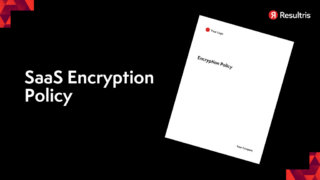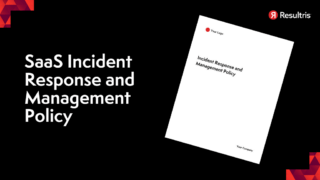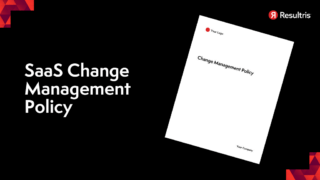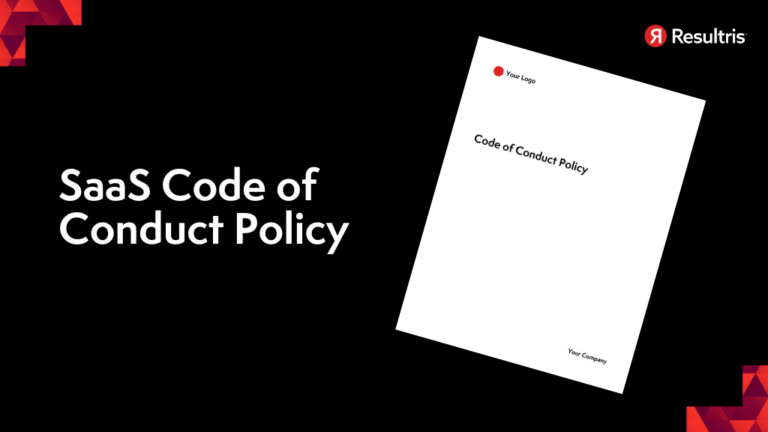
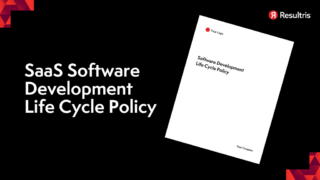
Written by: Tim Eisenhauer
Last updated:

Diving headfirst into the world of Software as a Service (SaaS)? You’re not alone. As businesses across the globe pivot towards cloud-based solutions, understanding the ins and outs of SaaS becomes crucial. And at the heart of this revolution lies a key player – the SaaS Code of Conduct Policy.
This policy isn’t just a set of rules. It’s a roadmap to success, guiding you through the labyrinth of SaaS Compliance and Security Best Practices. So, are you ready to unlock the power of SaaS? Let’s delve into the world of SaaS Code of Conduct Policy together.
Let’s delve into the core of SaaS Code of Conduct policies, their definition, purpose, and scope. Also, we’ll explore the reasons for their necessity in SaaS companies.
Under this subheading, we shed light on what a SaaS Code of Conduct policy means and its overarching role.
A SaaS Code of Conduct Policy is essentially a guideline. It aids in setting forth the rules and standards, ensuring that all actions taken by stakeholders align with the company’s ethical standards. It’s a manual, navigating the operations of an organization. It ensures transparency and consistency, which drives the steady growth of any SaaS business.
In SaaS environments, the Code of Conduct extends beyond internal affairs. It covers the interaction with clients and third-party affiliates. It sets boundaries, maintaining decorum, and ensuring ethical conduct between all stakeholders. More importantly, it’s a tool encouraging all parties to conduct their operations under the umbrella of good governance.
Next, let’s discuss the relevance of a Code of Conduct policy within SaaS companies, how it shapes the company culture, and its role in establishing ethical practices.
A Code of Conduct forms the backbone of a company’s culture and its inherent values. It’s the fabric that binds the organization, reflecting its mission, vision, and core values. Similar to how architectural blueprint gives shape to a building, the Code of Conduct defines and shapes the company’s ethos.
Being in the digital realm doesn’t excuse unethical behaviors. The Code of Conduct plays a crucial role in ensuring ethical business practices. It’s like a compass, guiding the actions of the employees, steering them towards morally right paths.
Finally, trust plays a fundamental role in any business-client relationship, and that’s where the Code of Conduct shines. It fosters credibility and trust, building stronger bonds with customers and partners. It’s not just a policy; it’s a statement, a commitment to ethical interaction that fosters mutual respect and growth.
Let’s forge ahead into the heart of the SaaS Code of Conduct policy, dissecting its key components. These core elements set the groundwork, drive the effectiveness of these policies, and promote a healthier work environment.
A defining aspect is the ethical standards and values. This component in any SaaS Code of Conduct strives for operational integrity. It’s the beacon guiding actions and choices within a company, be they financial dealings, competition, or public relations. Take, for example, a pledge to deliver reliable, quality service without sacrificing honesty or fairness. Employees, thus, work under clear, ethically bound directives, steering the company’s path in the marketplace.
The SaaS Code of Conduct should also lay down professional behavior guidelines. Your adherence to these standards ensures a respectful and harmonious work environment, optimizing productivity and teamwork. Such guidelines include respectful communication, avoiding inappropriate language, or refraining from any disruptive behavior. A standard rule might be treating colleagues with respect or endeavoring for excellence in all assigned duties.
Having robust data privacy and security practices is essential for every SaaS organization, primarily because the SaaS model is internet-led. Subsequently, comprehensive data protection rules help protect client information from cyber threats and data breaches—a basic privacy rule maybe implements strong passwords and secure networks to prevent unauthorized access.
Addressing Intellectual Property (IP) protection is another significant pointer. It’d fall, for instance, under not sharing confidential design documents without proper authorization or keeping software source codes within the secure confines of the company. Such safeguards are cardinal in retaining a competitive advantage for the SaaS company and warding off potential infringements.
Anti-discrimination and harassment policies also rate highly in the SaaS Code of Conduct, safeguarding diversity, and fostering mutual respect. Such a policy might read, “Strict intolerance for any form of discrimination, whether by sex, race, color, age, or religion.” It ensures the workplace remains inclusive, encouraging diversity and promoting harmony.
Lastly, the policy should detail clear conflict of interest guidelines. Full disclosure may be required when personal interest could potentially impact business decisions—a classic rule like abstaining from business transactions benefiting an employee’s interest. These policies, thus, avoid nepotism, favoritism, or any interference with impartial decision-making.
There you have it — the building blocks of an effective SaaS Code of Conduct policy.
Implementing a SaaS Code of Conduct policy requires active participation of various stakeholders. This section demystifies the roles and responsibilities of these stakeholders, bringing clarity to their expectations and operational boundaries.
Leadership dictates the pulse of any organization. For a SaaS Code of Conduct policy, it’s their role to steer the ship towards compliance. They define the vision, goals, and strategies that ensure adherence to the policy. By setting up audit controls, management-based risk evaluations, and security awareness campaigns, leadership creates a culture of accountability and consistency. Leaders not only drive policy observance but also promote exemplary conduct by embodying the company’s ethical values.
As backbone of an organization, employees play a significant role in application of a SaaS Code of Conduct policy. The policy defines their obligations, which include maintaining confidentiality, handling data responsibly, reporting breaches, and committing to continuous learning about compliance parameters. At the same time, the policy upholds their rights, such as equality, freedom from discrimination and harassment, data privacy and the right to a safe working environment. It forms a mutual pact between the organization and the employees, fostering a healthy, respectful and law-complying workplace.
Customers and users form the cornerstone of any business. The SaaS Code of Conduct policy sets the customer’s expectation by laying out clear guidelines for data protection, privacy, usage constraints and service parameters. The policy also defines processes for complaint handling and dispute resolution. Meeting or exceeding these expectations strengthens customer trust, fuels customer retention and drives business growth.
Vendors and Partners mirror your organization’s values to the external world. Thus, they must be at par with your SaaS Code of Conduct policy. Vendor and partner responsibilities outlined in the policy may cover confidentiality clauses, data breach notification protocols, supply chain integrity, and compliance with anti-bribery and corruption laws. An enforced contract ensures a seamless alignment of business objectives, elevating the reputation of your company.
The establishment of a SaaS Code of Conduct aligns the company’s values, industry standards, and legal requirements with the software services it offers. This section focuses on how to shape this essential document to mirror your business’s core principles.
Start by recognizing your company values and identifying the industry standards. Consider conducting a thorough audit that explores your organization’s ethos and the legal benchmarks in Software as a Service (SaaS) industry. Reflect your company’s ideals in aspects such as transparency, data privacy, and intellectual property protection. Remember, your SaaS Code of Conduct mirrors your values and can dictate the reputation you build in the industry.
Your next step gets down to drafting the SaaS Code of Conduct. You can’t stress enough the importance of clear, concise guidelines. Unclear rules cause confusion, breed misinterpretation, and inhibit compliance. So, make sure every clause in the document is straightforward, reframing complex ideas into simpler ones. Emphasize the expectations on ethical standards, anti-discrimination, and professional behavior. This guide becomes a blueprint, directing employees and users in the appropriate, lawful way to utilize your software services.
Fail to incorporate legal and regulatory requirements into your policy at your own risk. It’s not just about drafting a code that reflects company values—it needs to hold up to legal scrutiny, too. Research federal, state, and local laws on data privacy and intellectual property. Understand sector-specific regulations to ensure every policy point is compliant. If your software services span borders, think about international laws as well.
With a draft in hand, don’t forget the importance of a thorough check. Your review and approval process ensures that every line in the policy is spot-on, with no room for ambiguity. Implement multiple levels of review and seek legal approval to eliminate possible oversights. Let leadership take the helm of this process. After all, they set the ethical tone for the rest of the corporation. Successful review and approval of your SaaS Code of Conduct marks a solid step towards enhancing your company’s credibility and trust in the industry.
Once you’ve established your SaaS Code of Conduct, the real work begins. It’s in effective implementation that your policy transitions from a document to a living embodiment of your company’s values. Here goes a guide on robust planning that can aid in ensuring seamless integration of this integral policy into your organization.
From the start, your employees become your best allies in upholding your Code of Conduct. Employee training and onboarding processes ought to encompass comprehensive understanding of the policy in its entirety. For instance, a series of workshops could be designed that break down the policy, imparting to employees what’s expected of them and how the principles reflect the organization’s core values.
But, remember, a one-off training session isn’t sufficient. It’s the continual education and reinforcement that ensures your SaaS Code of Conduct remains at the forefront of everyone’s mind. Regular updates on the policy changes, themed-awareness weeks, or periodic quizzes, for instance, keeps the policy alive and relevant, fostering a culture that breathes your Code of Conduct.
Congratulations, your company’s not just about the talk-it’s about the walk too. Now embed the Code of Conduct into your business operations. Whether it’s daily processes, decision-making paradigms, or strategic planning – having your Code of Conduct as a cornerstone assures that you’re true to your business etiquette. For instance, integrating it into your performance evaluation systems or tying bonus structures to compliance could serve as practical steps towards embedding the policy.
Remember, creating and implementing a robust SaaS Code of Conduct isn’t just about adhering to industry norms. It’s about cultivating a corporate ethos that values ethical engagement, transparent practices, and employees who genuinely advocate for them. Compliance becomes not an obligation, but a reflection of your corporate character. This is how you create a sustainable SaaS business in today’s highly competitive marketplace.
Putting a SaaS Code of Conduct into action means more than just drafting the document. It involves enforcement, which guarantees it’s taken seriously by all company stakeholders. In this section, we’ll dissect the mechanisms used to enforce a SaaS Code of Conduct, from reporting violations to conducting investigations and dealing with those who disregard the policy.
A vital part of enforcing the Code of Conduct in a SaaS setup relies on an established reporting mechanism. This system permits members within the organization to voice concerns about potential policy violations in a safe, confidential manner. Here’s a typical setup:
After a report has been filed, a procedural investigation follows to determine if indeed a violation occurred. The main elements to take into account include:
Transgressions of the Code of Conduct are serious matters. The organization’s mode of addressing such violations can range from simple admonitions to expulsion and even legal actions. The key is consistency and proportionality; there’s no one-size-fits-all approach, but some measures include:
Enforcing a SaaS Code of Conduct requires a comprehensive strategy that includes ensuring the workforce understands the conduct expected of them, having mechanisms to report violations, investigations undertaken impartially, and a nuanced system of matching disciplinary actions to each violation. By considering these factors, organizations are well on their way to fostering a compliant and ethical work culture.
The management of a SaaS Code of Conduct comes with its fair share of challenges. These hurdles could range from constant industry changes to balancing innovative leap with ethical restraints and administering teams spread across the globe.
One major challenge you’d encounter in managing your SaaS Code of Conduct emerges from the dynamic nature of the SaaS industry. Technological advances and fast-paced innovation continue to reshape the industry. As changes occur, updating policies becomes an inevitable task, ensuring they align with emerging technologies, new business models, and shifting consumer preferences. Adapting your SaaS Code of Conduct to these rapid changes prevents it from becoming outdated, promoting agile conformity.
For instance, the rise of Artificial Intelligence (AI) in SaaS applications has introduced new ethical and compliance uncertainties. The evolving use of AI can make existing policies seem inadequate, precipitating frequent updates to address newer challenges.
Innovation is a key driver in the SaaS industry, pushing boundaries and creating novel technologies. Nonetheless, striking a balance between technological advancements and ethical limitations presents a considerable challenge in the management of your SaaS Code of Conduct.
Consider the case of data privacy and security. Although innovative tools might allow for deeper customer insight, they could also pose risks to user privacy. It’s imperative to consider how your SaaS applications handle user data, align this with your Code of Conduct, and continuously fine-tune your policy to give equal prominence to both innovation and ethics.
The SaaS wave transcends borders, which means, likely, your SaaS Business is operating with a global footprint. Given that, the third challenge you’d come across is ensuring your Code of Conduct holds steady across various geographical locations and cultures.
Consistently assuring all teams, regardless of their location, adhere to your Code of Conduct might seem like a daunting task. However, with frequent virtual trainings addressing cultural disparities and time zones, and establishing clear lines of communication, you can foster a remotely connected, yet ethically harmonized team. You gotta remember, the goal is to build a culture that respects local customs and regulations while upholding your company’s ethical standards. A well-managed Code of Conduct becomes a global unifying factor.
Assessing the efficiency of your SaaS Code of Conduct requires an inclusive approach, coupling quantitative metrics with qualitative feedback. Let’s delve into how you can establish a comprehensive measurement system.
Implement strategic KPIs to quantitatively measure the success of your Code of Conduct policy. Examples of such KPIs include the frequency of disciplinary instances, instances of code violation reports, and resolution times for reported issues.
Creating a table with this data provides a clear overview:
| KPI | Description |
|---|---|
| Disciplinary instances | Number of disciplinary processes initiated due to code violation |
| Code violation reports | Number of reports received about potential code breaches |
| Resolution time | Average time taken to address and resolve reported issues |
Integration of this data into your business dashboard assists with regular monitoring and quick detection of emerging trends or issues.
Investigate your workforce’s commitment to your SaaS Code of Conduct. Assess levels of comprehension, outline feedback mechanisms for policy improvement, and measure participation rates in mandatory trainings and workshops.
Enumerating these metrics does help:
Regular updates to these metrics can prove beneficial to gauge the employee engagement level with your policy.
Observe your code of conduct’s influence on your company’s reputation and customer trust levels. Garner insights from client surveys, media mentions, and social media platforms.
Recall these specifics:
Remember, measuring the impact of your SaaS Code of Conduct is an ongoing process. Awareness of the dynamism inherent to this policy ensures continuous revision and enhancement, thus safeguarding your company’s ethical integrity.
When it comes to SaaS Code of Conduct, there’s more to consider than just ethical standards and industry best practices. To ensure total compliance, it also needs to align with prevailing labor laws and industry-specific regulations, tailored to jurisdictions where your business operates.
Staying compliant doesn’t stop at your service offerings; it also extends into your working environment. It’s essential to align your Code of Conduct with existing labor laws. Ignoring them can lead to serious legal consequences such as fines, loss of operation licenses, unscheduled audits, or employee lawsuits. For instance, it’s important to uphold labor rights, fair wage policies, and workplace safety, fostering an environment that respects diversity and eliminates discrimination.
Another key aspect to consider is industry-specific regulations. If you’re dealing with health data, for example, adhering to HIPAA (Health Insurance Portability and Accountability Act) becomes mandatory in the U.S. Similarly, if your SaaS business caters to customers in the European Union, you have to comply with the GDPR (General Data Protection Regulation). These regulations protect user privacy and put strict rules regarding storing and sharing personal information. Non-compliance can result in hefty fines, bad publicity, and loss of customer trust.
Running a global SaaS business? Then remember: every region comes with its own set of rules. Each country has unique regulations and laws that you must adhere to. Moreover, some regions have stringent data sovereignty laws that define how and where you should store user data. For example, Russia requires companies to host its citizens’ data on servers within the country. Failing to comply could lead to expensive legal battles, or worse, being blocked from operating in that region. Ergo, maintaining international compliance in your Code of Conduct is a necessary deterrent to these risks.
Adapting a SaaS Code of Conduct proves essential for different stakeholders. It’s vital to ensure its references and pertinence to a range of individuals interacting with your SaaS platform.
For employees, the Code of Conduct serves as a compass, guiding their interactions and decision-making processes. Employees often encounter scenarios that demand ethical judgments; therefore, a well-drafted Code of Conduct provides clear expectations regarding acceptable behavior. For instance, it may delineate guidelines for confidentiality in handling customer data, conflict of interest, and proprieties in financial transactions. Consistent adherence to the Code by employees fosters a culture of accountability, reinforcing the ethical foundation of your SaaS business.
In addition to employees, the Code of Conduct should also consist of policies applicable to customers and users. Given the varied interactions these individuals have with the SaaS platform, guidelines need to be in place surrounding data privacy, access rights, and user responsibilities. Notably, users of the platform should understand their obligations regarding appropriate use of the service, along with their rights concerning data privacy and security. Customer and user guidelines not only protect the integrity of your platform but also instill a sense of trust and security in your user base.
Lastly, partners and vendors constitute an integral part of a SaaS enterprise. Therefore, adopting a Code of Conduct that encompasses their activities assures ethical alignment. For example, you should define the standards for issues relating to procurement, conflict of interest, and intellectual property rights. This type of ethical requirement solidifies partner relationships, underpins trust, and maintains the integrity of your business supply chains. By creating distinct, stakeholder-specific guidelines, you build a comprehensive, effective Code of Conduct capable of governing ethical conduct across all facets of your SaaS operation.
Diving further into the world of SaaS ethics, we’ve spotted some emerging trends that promise to mold the future of how businesses address conduct in the SaaS sector.
With AI being a staple in many SaaS platforms, Algorithmic Bias becomes a key ethical concern. It’s crucial to acknowledge that algorithms can unintentionally support unfair biases. For example, an AI-based hiring tool might favor resumes from certain universities due to an initial bias in its training data. Companies nowadays adopt Algorithmic Transparency as a standard practice, allowing external audit of their AI systems. They are striving to design diversity-aware algorithms, minimizing discriminatory practices and bolstering fairness in all SaaS operations.
Environmentally-friendly and socially responsible practices are gaining traction in the SaaS sector. A franchise of thought, known as Green SaaS, champion eco-friendly cloud solutions and energy-efficient data centers. For instance, Google’s Green Energy Purchasing Program aimed at offsetting electricity usage in their cloud services. Social responsibility, on the other hand, emphasizes ethical user data handling, fair labor practices, and community involvement. Tech companies like Salesforce, through their 1-1-1 model, dedicate resources for social good, setting a commendable standard for community outreach and involvement within the industry.
Data ethics and responsible innovation are two central pillars of modern SaaS ethics. As a SaaS provider, ensuring data privacy for user information is not just a legal necessity, but an ethical responsibility. Users entrust their data to SaaS platforms, and respecting that trust by adhering to stringent data privacy policies is of paramount importance. For instance, Microsoft’s Privacy by Design initiative mandates data minimization and seeks express user consent before accessing personal data. Similarly, responsible innovation advocates for a balance between technological advancements and potential ethical ramifications. For example, while developing an AI chatbot, it’s essential to consider user privacy and manage the challenges posed by deepfakes or manipulated media. You’re not only innovating, but also navigating the thin line between advancement and intrusion responsibly.
These emerging trends are a testament that SaaS ethics and conduct keep evolving, molding to fit new challenges and opportunities. Adapting to these shifts will not only ensure ethical and responsible operations but also solidify your stand as a trustworthy, future-ready SaaS provider.
When a crisis hits your SaaS company, your Code of Conduct policy plays a pivotal role in steering you through the storm. Let’s delve into how crucial sections of your policy like Public Relations, Ethical Breaches, and Policy Updates could step up when trouble looms.
Public Relations (PR) can be a minefield, especially in a crisis. Your Code of Conduct Policy is your road map here. Staying true to your organization’s principles at all times, even when the heat is on, reinforces trust, enhances credibility and helps you navigate any PR fallout. Mismanaged PR drama, for instance, may tarnish your brand reputation, pushing clients towards the exit.
Major ethical breaches strike at a company’s integrity, often causing deep-rooted damage. Strict adherence to your Code of Conduct policy mitigates this threat. Consider, for instance, a data breach. Tight adherence to data protection policies in your Code of Conduct not only helps prevent breaches but also ensures you’re prepared if one occurs. Fast, honest, full disclosure, as outlined in your policy, instills client trust, even during difficult times.
Crises leave lessons in their wake. An updated Code of Conduct ensures you integrate these lessons, enhancing resilience and reducing future risk. Post-crisis, you might reevaluate your policy, highlighting areas needing reinforcement. For instance, after a security breach, tighten your data security protocols and establish firmer guidelines to maintain client trust. This way, your Code of Conduct remains your strongest shield and smartest guide as your SaaS company muscles through a crisis, and grows stronger in its aftermath.
Professional standards and company culture, two concepts often perceived as poles apart, need a harmonious blend for the smooth sailing of any SaaS company. This section goes under the surface to reveal how the SaaS Code of Conduct Policy strikes this balance.
Innovation, the lifeblood of the SaaS industry, often walks a thin line with ethical standards. How do you maintain boundaries without stifling creativity? Here’s where your Code of Conduct comes into play. Rather than a dampener, it acts as a roadmap, guiding your innovators through the maze of professional ethics. It defines clear “Do’s and Don’ts” for data usage, privacy, security and a host of other dimensions, where overstepping could lead to potential violations. Simultaneously, it fosters an atmosphere of open dialogue, raising awareness on emerging ethical dilemmas. For instance, predictive analytics, a marvel in the hands of your developers, when used without restraint, could infringe user privacy. It’s your Code of Conduct that advices caution against unregulated use, emphasizing responsible innovation.
In an industry as globally proliferated as SaaS, navigating cultural differences is a must. But, cultural insensitivity carries the risk of creating a toxic work culture. Here’s where your Code of Conduct comes to the rescue. It roots the company culture in respect and understanding, coupled with an intrinsic commitment to equal opportunity, irrespective of cultural backgrounds. It addresses potential sources of bias in recruitment, performance evaluations, and promotions, rooting out potential discrimination, while also encapsulating appropriate communication methods. After all, might not a slang in your home country be offensive in another? It’s your Code of Conduct that becomes your team’s cultural translator, smoothing out cross-cultural interactions and fostering an inclusive, diverse workforce.
In the world of SaaS, communication is key. The Code of Conduct isn’t merely a document but the ethical bedrock of your business governing every interaction. This section will focus on strategies for crafting, enhancing, and communicating your Code of Conduct internally and externally.
Maintaining an open line of communication helps foster a culture where everyone understands and adheres to the policy. Begin by educating your staff. Use engaging presentations, workshops, and regular training sessions. Make awareness of the Code of Conduct part of your organizational fabric, integrating it into your employees’ workflow.
Provide a clear process for reporting violations. Ensuring that employees who have concerns know where to go is essential in enforcement of the code. It’s also crucial to protect the identity of whistleblowers in the company, making sure they’re not afraid to speak up.
Board and management support is vital. The top-down approach shows employees that everyone, regardless of rank, is held accountable. Would it be a widely respected Code of Conduct if it’s not executed across all levels of the company right?
It’s integral to the process that customers, partners, and vendors know about the Code of Conduct. It shows them your commitment to ethical business practices. Make your Code of Conduct accessible. Feature it prominently on your website, ensuring it’s easy to find and understand.
Ensure transparency in terms of how you enforce the code. Detailed, honest reporting showcases the efficiency of your enforcement and underpins public confidence. Don’t forget, an open communication strategy goes a long way in promoting trust.
Be clear about the consequences for violating the code. It’s not a tick-box exercise. This document has teeth and shows how seriously your organization treats misconduct.
Feedback, both from internal and external sources, can provide invaluable insights for improving your Code of Conduct. Keep the channels open. Encourage conversations about the code.
Take effective measures to review and revamp the code periodically based on feedback. Incorporating these changes supports continued growth. Maybe there’s a section that’s not clear, or perhaps there’s an issue you didn’t foresee. It’s a living document, it shouldn’t be static.
Always remember, your Code of Conduct isn’t a rigid set of rules; rather, it should be a dynamic tool that evolves with your organization. In essence, communicating your SaaS Code of Conduct effectively shapes the ethical landscape of your enterprise. It’s not only about setting the right expectations but ensuring that they are understood, followed, and continuously improved.
Your business integrity thrives when your SaaS Code of Conduct seeps into every corner of your enterprise, melding seamlessly with other company policies. This blending constitutes a harmonious policy ecosystem where standards coexist and support each other.
Human Resources play a vital role in upholding your Code of Conduct. Aligning your policy with HR regulations ensures an ethical workspace, fostering both employee satisfaction and company goals. For instance, if your Code of Conduct specifies zero tolerance for bullying, your HR policies must reflect corresponding disciplinary procedures. This alignment fosters an ethically sound environment, heightening productivity, and retaining talent.
In a hyper-connected SaaS business, securing client and company data is crucial. Your Code of Conduct should coordinate with information security policies. This coordination clarifies your stance on users’ privacy and data protection, reinforcing trust in your services. Say your Code of Conduct upholds the principle of confidentiality. Your Information Security policies then need to outline actionable data protection strategies, such as data encryption or two-factor authentication.
Integrating your Code of Conduct with customer service guidelines promotes consistent service ethics. For example, if your Code norms promote transparency, your Customer Service team, dealing with client queries, must maintain straightforward communication. Insights into service disruptions, refund policies, or billing queries can therefore be shared honestly, bolstering customer relationships and engendering loyalty.
The more interconnected your policies, the more holistic your business approach. To this end, integrating your SaaS Code of Conduct with other policies establishes an ethics-rich business ecosystem. It’s not just about drafting a Code of Conduct. It’s about embodying it across all business operations.
Having a SaaS Code of Conduct Policy isn’t just a box to tick off. It’s an essential part of your business’s ethical backbone. This policy not only ensures compliance and security, but it also acts as a beacon guiding your company’s ethical conduct. It’s a tool that helps tackle emerging ethical issues like AI bias and crisis management.
But remember, a Code of Conduct Policy isn’t an island. It’s integral to integrate it with other policies like HR, information security, and customer service. By doing so, you’re creating a harmonious policy ecosystem that embodies ethics across all operations. It’s about fostering an ethical SaaS culture that goes beyond compliance. It’s about setting the right standards, making the right decisions, and ultimately, doing the right thing. Your SaaS Code of Conduct Policy isn’t just about what you do—it’s about who you are as a company.
Disclaimer
Please note that the information provided in this blog post is for informational purposes only and does not constitute legal advice. We are not lawyers, and reading this content does not create an attorney-client relationship. For legal advice specific to your situation, please consult with a qualified attorney.


